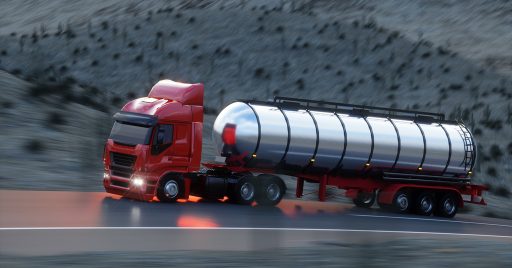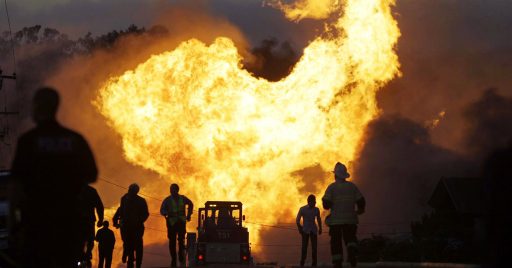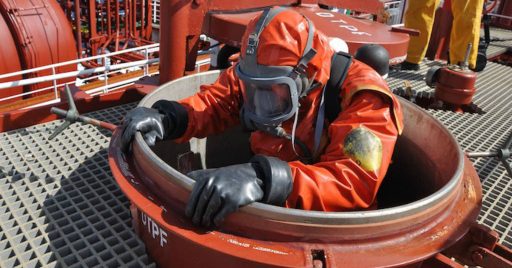According to the ILO, more than 6 million people are directly employed by the petroleum industry, and based on the BLS reports, around 145,000 part-time and full-time employees work in the US oil and gas extraction industry. On the other hand, oil and gas exploration and production is the third biggest industry by revenue in the world. Those numbers demonstrate how much this industry is significant.
Working in such a vast industry has so many safety risks. Census of fatal occupational injuries (CFOI) statistics show that from 2013 to 2017, about 487 workers were killed in the US oil and gas extraction industry. Therefore HSE in the oil and gas industry is so vital.
The six fatal hazards in the oil and gas industry consist of vehicle accidents, struck-By, explosions and fires, falls, confined spaces, and chemical exposures. Employers, HSE managers, or other safety authorities must protect the workers from these dangers. They must implement a risk assessment and provide proper health and safety plan to avoid accidents.
Table of content
1- Transportation incidents
From 2003-2012, 433 fatal events in the US oil and gas industry occurred during transportation incidents.
Driving, especially with heavy loads and trucks, is dangerous. In the oil and gas industry, loads must transport to gas stations, petroleum factories, pumping stations, pipelines, harbors, or other sites. Transporting different loads like equipment or pipes on Long roads and highways between cities in abnormal climatic conditions is hazardous. Besides inclement weather, drivers’ fatigue and health conditions could increase vehicle accidents possibility.
According to OSHA, all these dangers make vehicle accidents the first oil and gas fatal hazards in the US.

2- Contact with object/equipment
According to OSHA, Struck-by, caught-in, or caught-between hazards cause three of every five on-site fatalities in the oil and gas extraction industry. These hazards resulted in 283 deaths from 2003 till 2012, in the US.
Different situations and reasons can cause such deadly incidents, including moving vehicles, lifting loads by mobile or tower cranes, falling equipment, or even high-pressure lines. 209 deaths occurred while some object or equipment struck workers. Then statistics show struck-by is a common fatal hazard in the oil and gas industry.
3- Fire or Explosion
From 2003 to 2012, 101 workers were killed due to explosions, and 56 employees died in fire accidents. Fire and burst in the oil and gas industry are the third fatal hazard in this category.
Hot work, welding, cutting, and open flames are some apparent fire and combustion hazards in the oil and gas extraction sites. Flammable vapors and hydrogen sulfide are the other hazards that can not be easy to spot, but they may be quick to smell. Besides these perceptible dangers, there are still other fire and explosion hazards in oil and gas sites, such as static electricity and changing weather conditions.
Safety authorities must control and monitor all these fatal hazards in oil and gas sites besides providing proper PPE for every worker to prevent explosion and fire accidents.

4- Fall, slip, trip
According to NIOSH, from 2003 to 2012, 83 workers were killed due to fall, slip, or trip in the US oil and gas industry. Slips and trips often happen in oil and gas sites because of poor housekeeping, oily surfaces, low lightening, etc.
On the other hand, many activities in this industry implement high above the ground. Since working at height are not avoidable, employers and HSE managers must consider all safety equipment to prevent fatal accidents.
5- Confined spaces
Oil and gas workers are usually required to enter and work in confined spaces. These dangerous spaces could be in excavated areas like mud pits and reserve pits or be around a wellhead such as sand storage containers or other confines spaces like storage tanks. Entry and working in such hazardous areas often need permissions.
Confined space hazards in the oil and gas industry include toxic gasses and vapors, flammable gasses and vapors, and exposure to oxygen-deficient or oxygen-rich atmospheres. Working in such places also could be hazards like loud noise and low visibility.

6- Chemical exposures
Reports on accidents related to chemical exposures are rare, but some evidence shows some hazards like volatile petroleum hydrocarbons’ inhalation caused fatal incidences. Other chemical exposure risks include silica, diesel emissions, components of fracturing fluids, hydrocarbons, and other volatile organic compounds, hydrogen sulfide, acids/bases, biocides (aldehydes, others), polycyclic Aromatic Hydrocarbons, and metals (Pb). Employers must be sure that everyone takes all safety precautions when working with chemicals.